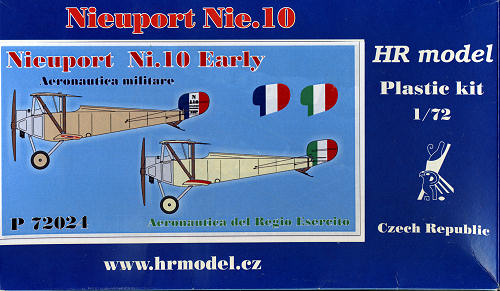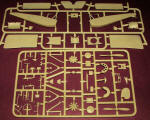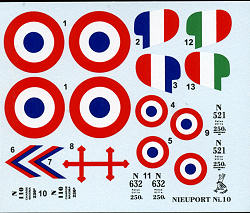
| KIT #: | P72024 |
| PRICE: | 360 Koruna - about $17.25 - from www.hobbyshop.cz |
| DECALS: | Four options |
| REVIEWER: | Scott Van Aken |
| NOTES: |

| HISTORY |
In January 1914, designer Gustave Delage joined the Société Anonyme des Etablissements Nieuport, and started to design the series of aircraft that made him and the company famous. The first of these was the Nieuport 10, originally designed to compete in the Gordon Bennett Trophy race of 1914. World War I caused this contest to be cancelled, and the type was developed as a military two seat reconnaissance aircraft that entered service in 1915.
The type featured a distinctive "V" strut layout. The lower wing was much smaller in area than the upper wing, and the concept was intended to combine the strength of the biplane's wire braced wing cell with the good visibility of the parasol monoplane.
As a two-seater, the type proved to be underpowered - many were converted to single seat fighters by simply covering the front cockpit, and adding an upward firing Lewis machine gun to the center section of the top wing. In this form, the type was used as a fighter.
Two types were developed from the Nieuport 10 - the Nieuport 11 Bébé - a smaller aircraft, designed from the outset as a single seater, and the Nieuport 12 - a more powerful two-seater.
| THE KIT |
 In line with the previously previewed Hanriot, this kit has two nicely molded sprues that contain a bunch of parts that are not required for the kit being boxed. There are two different engine cowlings, two different engines, two different props, two different upper wing center sections and three different upper cowling pieces. There are also three different guns.
In line with the previously previewed Hanriot, this kit has two nicely molded sprues that contain a bunch of parts that are not required for the kit being boxed. There are two different engine cowlings, two different engines, two different props, two different upper wing center sections and three different upper cowling pieces. There are also three different guns.
Well this kit builds the Nieuport 10s operated by the Italians and the French. The aircraft was built as both a single and two seat aircraft and both options are used in this boxing. Typical of the genre, there is not all that much to the interior aside from seats, control sticks and rudder pedals that fit on a nicely done floor. There is a fuel tank that occupies the front seat area for the single seat aircraft.
For the single seat aircraft, you have a choice of guns that you can place on the upper wing. The upper wing center section with a circular hole is for the two seat version so the observer can see upwards. The kit instructions, which are well drawn, has assembly steps for the single and two seat aircraft separate in most cases and in others it clearly points out which is which. I should also mention that there are several acetate windscreen options for these planes as well.
and in others it clearly points out which is which. I should also mention that there are several acetate windscreen options for these planes as well.
The box art shows two of the four options, both of these two seat planes. The French option is simply listed as being with the Aeronatuca Militaire in 1914 while the Italian aircraft is with the Aeronautica del Regio Esercito in 1915. This aircraft has the lower wing with a large area of red on one side and green on the other. The other two options are both French. A single seat plane with a red and blue chevron is armed from 1915, while the other is in aluminum dope with a cross of Lorraine on the upper fuselage. from 1914. This latter plane is one with a fuselage insignia. The decals are ery nicely printed and if typical of Czech decals, will be quite thin. Again, there is no rigging diagram aside from what can be gleaned from the side profiles.
| CONCLUSIONS |
This is yet another super little WWI model kit, this time, something from the early days of the war and in many respects, the start of a term of several years with Nieuport sesquiplanes were front line aircraft. It is short run so some modeling skills are needed and it would have been nice to have had a full rigging guide, but one can probably work their way around that.
| REFERENCES |
http://en.wikipedia.org/wiki/Nieuport_10
July 2012
Thanks to www.hobbyshop.cz for the preview kit. You can get yours at the link.
If you would like your product reviewed fairly and fairly quickly, please contact the editor or see other details in the